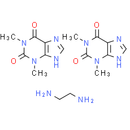Description
Aminophylline is an inhibitor of cAMP or cGMP phosphodiesterases, increasing levels of the second messenger cAMP or cGMP intracellularly, also acting as a CNS stimulant and exerts a positive chronotropic and inotropic effect on the heart.
Product information
CAS Number: 317-34-0
Molecular Weight: 420.43
Formula: C16H24N10O4
Synonym:
Somopphyllin
Aminocadol
Phyllocontin
Chemical Name: 1,3-dimethyl-2,3,6,7-tetrahydro-1H-purine-2,6-dione; ethane-1,2-diamine
Smiles: CN1C2NC=NC=2C(=O)N(C)C1=O.CN1C2NC=NC=2C(=O)N(C)C1=O.NCCN
InChiKey: FQPFAHBPWDRTLU-UHFFFAOYSA-N
InChi: InChI=1S/2C7H8N4O2.C2H8N2/c2*1-10-5-4(8-3-9-5)6(12)11(2)7(10)13;3-1-2-4/h2*3H,1-2H3,(H,8,9);1-4H2
Technical Data
Appearance: Solid Power
Purity: ≥98% (or refer to the Certificate of Analysis)
Solubility: DMSO : 14.29 mg/mL (33.99 mM; Need ultrasonic)
Shipping Condition: Shipped under ambient temperature as non-hazardous chemical or refer to Certificate of Analysis
Storage Condition: Dry, dark and -20 oC for 1 year or refer to the Certificate of Analysis.
Shelf Life: ≥12 months if stored properly.
Stock Solution Storage: 0 - 4 oC for 1 month or refer to the Certificate of Analysis.
Drug Formulation: To be determined
HS Tariff Code: 382200
How to use
In Vitro:
Aminophylline is a compound of the bronchodilator theophylline with ethylenediamine in 2:1 ratio. The ethylenediamine improves solubility, and the aminophylline is usually found as a dihydrate. Aminophylline is less potent and shorter-acting than theophylline. Its most common use is in the treatment of airway obstruction from asthma or COPD. It is used off-label as a reversal agent during nuclear stress testing. Aminophylline is a nonselective adenosine receptor antagonist and phosphodiesterase inhibitor. Adenosine is an endogenous extracellular messenger that can regulate myocardial oxygen needs. It acts through cellular surface receptors which effect intracellular signalling pathways to increase coronary artery blood flow, slow heart rate, block atrioventricular node conduction, suppress cardiac automaticity, and decrease β-adrenergic effects on contractility. Adenosine also antagonizes chronotropic and ionotropic effects of circulating catecholamines. Overall, adenosine decreases the heart's rate and force of contraction, which increases blood supply to the cardiac muscle. Given specific circumstances this mechanism (which is intended to protect the heart) may cause atropine-resistant refractory bradyasystole. Adenosine's effects are concentration-dependent. Adenosine's receptors are competitively antagonized by methylxanthines such as aminophylline. Aminophylline competitively antagonizes the cardiac actions of adenosine at the cell surface receptors. Thus, it increases heart rate and contractility.
References:
- Ming-Chih Yu, et al. Luteolin, a non-selective competitive inhibitor of phosphodiesterases 1-5, displaced [3H]-rolipram from high-affinity rolipram binding sites and reversed xylazine/ketamine-induced anesthesia. ur J Pharmacol. 2010 Feb 10;627(1-3):269-75.
- E Tai, et al. Response of blood gas tensions to aminophylline and isoprenaline in patients with asthma. Thorax. 1967 Nov;22(6):543-9.
- Daly JW, et al. Adenosine receptors: development of selective agonists and antagonists. Prog Clin Biol Res. 1987;230:41-63.
Products are for research use only. Not for human use.
Payment & Security
Your payment information is processed securely. We do not store credit card details nor have access to your credit card information.


